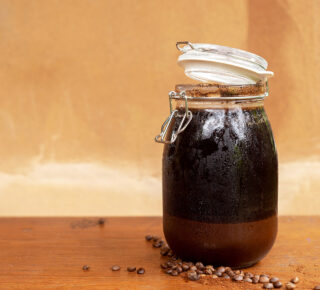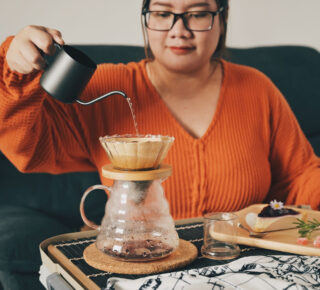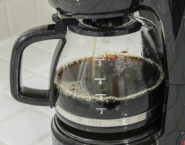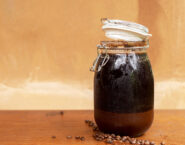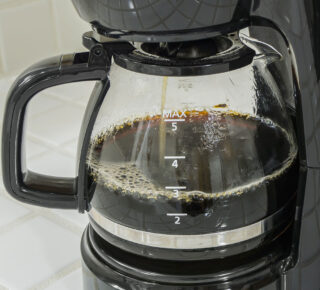
What is French press coffee? This brew is named for the device used to make it: the French press, which you also may see referred to as a cafetière, coffee press or coffee plunger. It’s a simple, manual coffee maker that allows coffee grounds to gently steep in just-boiled water until brewing is complete; then, a filter is pressed, or plunged downward to separate the brewed coffee from the grounds.
Among all the other coffees you can make at home, what is French press coffee known for? Bold flavor and a full body—and the longer the brew time, the bolder your final cup will be. Coffees with a medium to dark roast tend to work well in a French press, but you can experiment with different roasts to find what you like best.
Here’s how to make French press coffee so that you get the best freshness and flavor—with tweaks that can help you find your perfect cup.
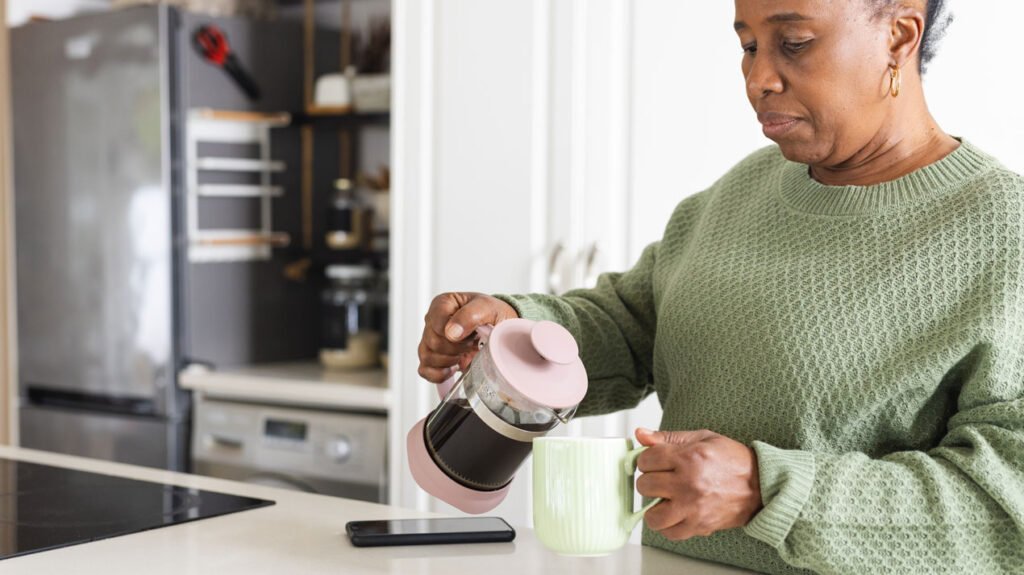
Equipment
To make French press coffee, you will need:
- French press
- Kettle or other hot water source
- Thermometer (unless one is built into kettle)
- Scale
- Grinder (optional, but preferred)
A French press
A French press includes a cylindrical carafe, a plunger, and a built-in filter that percolates the coffee. While it’s a fairly simple brewing device, there are still a wide variety of options out there to consider.
When considering what type of French press to buy, start by considering the materials used. You can choose between glass, stoneware, plastic, and metal French presses, and for glass and metal, you have single- and double-walled options. The double-walled options maintain a more consistent temperature throughout the brewing, which makes for higher-quality coffee, and, after brewing, keep the coffee hot for longer.
As you compare these options, you’ll also want to consider durability. Which material will hold up best when you’re making coffee while still waking up (and not at your most coordinated)?
Here are a few other key factors to keep in mind—and questions to ask yourself.
- Cost: What’s your price range for your French press? The double-walled options generally will cost more, as will some of the stylish stoneware options.
- Capacity: How many cups of coffee do you need to make at one time? You can find French presses of different sizes designed to make large or small batches. For the best coffee, it’s better to match the size to the batch—you lose quality trying to make a small batch in a larger device.
- Design: French presses come in a range of styles and even colors. What fits your aesthetic and the style of your kitchen?
- Customer reviews and ratings: There’s nothing like hearing from others who have used a French press—what are they saying about your top choices? It can be especially helpful to look for feedback on filter quality, which can be difficult to judge before using.
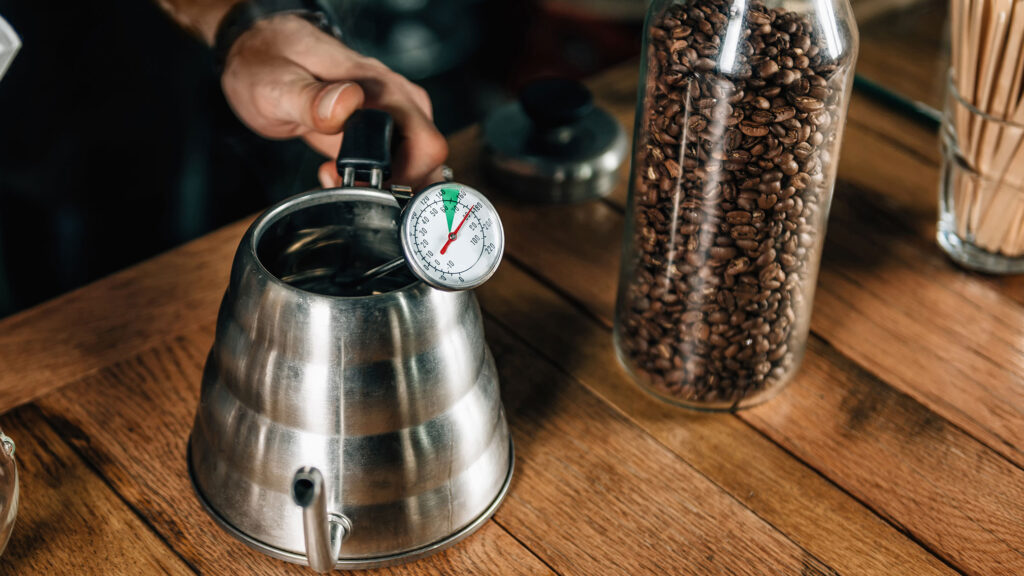
A kettle and thermometer
You can use standard electric or stove-top kettles to make French press coffee. If you’re using a kettle that does not have a built-in thermometer, plan to have one on hand—the ideal water temperature for a French press is around 93 ± 3°C.
You also can boil water on the stove or in the microwave, but it’s harder to control the temperature, which can affect the quality of the coffee.
Scales
Using a digital scale to measure your coffee and water will help you brew more consistent French press coffee—and keep track of what worked well (or not) for you so you can keep adjusting and experimenting.
Grinders
While you can buy and use ground coffee, buying whole coffee beans and grinding them immediately before brewing guarantees maximum freshness.
There are two types of grinders: burr (or mill) grinders and blade grinders. We recommend using a burr grinder—whether at home or where you buy your coffee beans.
Burr grinders
A burr grinder crushes coffee beans between a moving grinding wheel and a non-moving surface (the two “burrs” in the name). These grinders do a better job of creating a consistent grind, extracting the flavor of the coffee more evenly, and they’re better for the types of coffee that require smaller grind sizes, like espresso or French press coffee. They’re also less likely to overheat the grounds, preserving the coffee’s oils and aromas.
Blade grinders
A blade grinder is less refined than a burr grinder, with a metal blade that spins to grind the beans. It functions a lot like a food processor, so how long you run the grinder determines how coarse or fine the grind is, though it’s not always easy to control. You can’t ensure a consistent grind, which impacts taste. However, you can get to know your grinder over time and determine the right length of grinding time for your preferred cup of coffee
Whichever grinder you choose, always follow the manufacturer’s recommendations while using it, and be mindful of any necessary safety considerations.
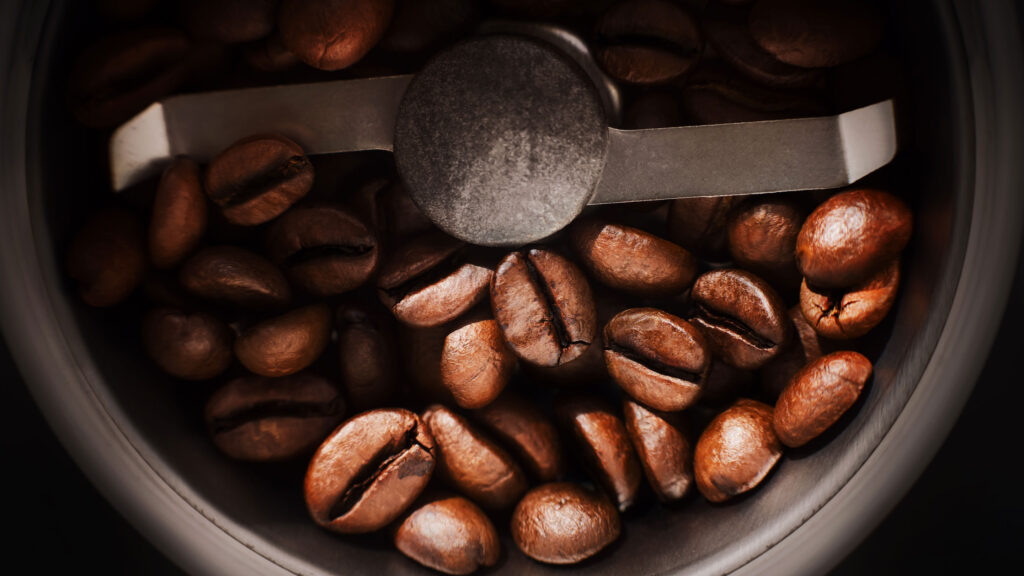
How to grind coffee beans
The size of your coffee grind makes a significant impact on the taste of your coffee. Knowing how to grind coffee beans starts with your brewing method. If you’re having your coffee ground where you buy it, just decide in advance how you plan to brew it.
As a general rule, the longer the coffee is in contact with water during the brewing process, the coarser the grind should be. That’s why espresso, which brews in seconds, requires a fine coffee grind, while cold brew, which may take hours to prepare, typically requires a coarse grind.
Pick your French press coffee grind size
To find the best French press coffee grind size, start with a coarse grind, then adjust as needed to brew your perfect cup.
| Brewing Method | Size of Coffee Grind |
|---|---|
| French press | Coarse (like rock salt) |
| Cold brew | Coarse |
| Drip | Medium (like kosher salt) |
| Pour-over | Medium |
| Espresso | Fine (like table salt) |
Coffee grind size and taste
If you’re not getting the taste you prefer—or if you just want to experiment with your coffee grind—try adjusting in one of two ways.
- Your coffee tastes bitter or sour: it may be ground too fine (over-extracted), so try a larger, coarser grind.
- Your coffee tastes flat or watery: it may be ground too coarse (under-extracted), so try a smaller, finer grind.
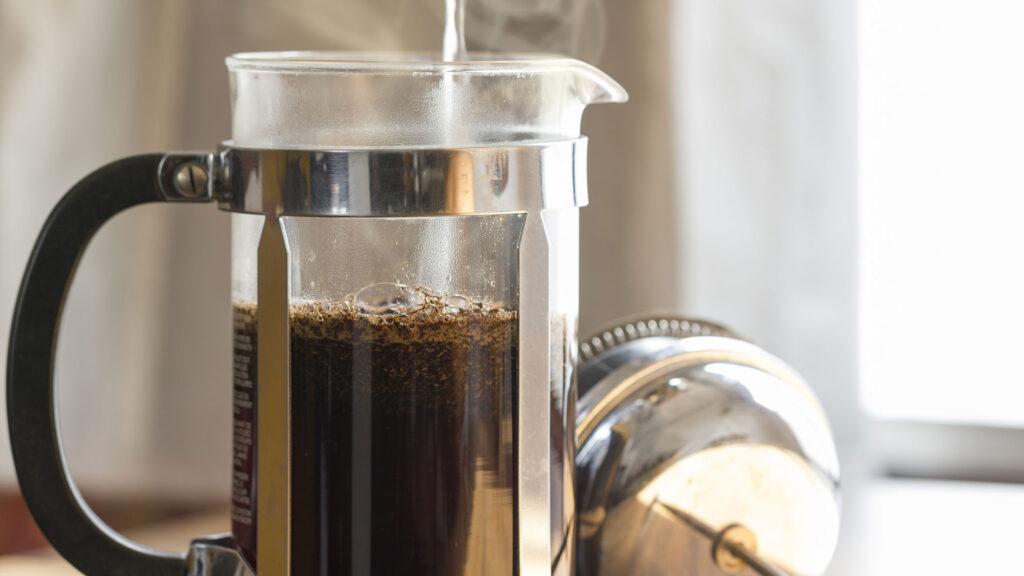
How to make French press coffee
Making French press coffee is a simple and straightforward process that results in a robust, satisfying cup. There are three consistent elements of how to make French press coffee you’ll love:
Sippable Fact
For French press coffee, here are the quick numbers you need to know:
- Coffee-to-water ratio: 1 gram of coffee to 10–16 grams of water (1:10 to 1:16)
- Brewing temperature: 93 ± 3°C
- Brewing time: 4 minutes, approximately, of contact between coffee and water
Step-by-step guide: How to make French press coffee
Here are the general steps for how to make French press coffee, which you can adapt to suit your device and preferences.
- Bring your water to a boil, remove from heat and allow to rest for about 30 seconds. Use your thermometer to confirm the water is around 93 ± 3°C (or your preferred temperature).
- Add your ground coffee to the carafe and then the hot water.
- Wait about one minute, until you see coffee grounds forming a “crust” at the top of the carafe. That’s normal! Just use a wooden spoon to stir gently, breaking up the crust.
- Put the lid on the carafe—with the plunger pulled all the way up—and allow the coffee to steep for about three more minutes.
- Gently push the plunger all the way down and serve immediately, or transfer to another container. (If left in a French press, coffee will continue to brew and turn bitter.) Enjoy!
How to clean up after making French press coffee
It’s important to clean your equipment and tools after each use, following the instructions specific to your French press.
Generally speaking, clean your entire French press after each use, including disassembling and washing the filter. Any coffee grounds and coffee oil (caffeol) left on the device can make your next cup taste bitter. Future you will be grateful!
Have you perfected your French press technique? Explore other coffee brewing methods like drip, pour-over, espresso, and cold brew.
Safety should always be a top priority when preparing, serving, or drinking any hot beverage—please take all necessary precautions! Be sure to follow all the specific instructions for use, cleaning, storage and maintenance provided with your brewing equipment and tools (including but not limited to brewing machines and devices, grinders, kettles, scales and filters). Be mindful of how hot liquids and equipment may get during the brewing process, and if you grind your coffee, be particularly careful with the sharp blades.

